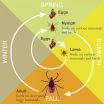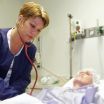(Press-News.org) Using a simple device for eight hours a night to treat sleep apnea can help people with prediabetes improve their blood sugar levels and may reduce the risk of progressing to diabetes, according to a new study published online in the April 21, 2015, issue of the American Journal of Respiratory and Critical Care Medicine.
About 57 million Americans have prediabetes, a disorder marked by blood sugar levels that are elevated but not sufficiently high to be considered diabetic. Prediabetics are at increased risk for developing diabetes, which can damage the eyes, kidneys, nerves and blood vessels and often leads to cardiovascular disease.
Many people with prediabetes also have untreated sleep apnea, although few of them are aware of it. The most widely accepted treatment for sleep apnea is continuous positive airway pressure (CPAP), a device that blows a constant pressure of air into the lungs through a tube and face mask during the night. This helps people breathe better while they sleep by keeping the upper airway open.
"Our study showed that CPAP in patients with prediabetes can lower their risk of progressing to diabetes when CPAP is used for eight hours, a full night's sleep," said the study's lead author, Sushmita Pamidi, MD, a former fellow at the University of Chicago who is now on the faculty at McGill University in Montreal, Canada.
"Although eight hours of CPAP per night can be difficult to achieve in real-life, our results should provide a strong incentive for anyone with sleep apnea, especially prediabetic individuals, to improve adherence to their treatment for cardio-metabolic risk reduction," she said.
People with sleep apnea, which is common among overweight and obese individuals, have repeated episodes where their upper airway closes during sleep. This can disrupt sleep and temporarily lower oxygen levels. It has been associated with an increased risk of cardiovascular diseases, such as hypertension and stroke, and may decrease their ability to regulate blood sugar levels. This increases the risk of diabetes.
For this study, the researchers recruited 39 middle-aged, overweight or obese volunteers with prediabetes and sleep apnea. Two-thirds of them (26) were randomly assigned to two weeks of CPAP treatment. The other 13 received a placebo -- a pill containing no medicine -- to be taken 30 minutes before bedtime. They were told the study would compare the two treatments.
All participants slept in the sleep laboratory and were closely monitored with all-night sleep recordings during the treatment period. Those assigned to CPAP wore the device for eight hours a night under continuous supervision by a technician. Before and after each treatment period, participants' glucose metabolism was assessed by oral and intravenous glucose-tolerance tests.
The researchers also measured the stress hormone noradrenaline in the blood and continuously monitored blood pressure for 24 hours at home. All participants were permitted to leave the laboratory during the day and engage in their routine activities.
After two weeks, blood sugar control, as measured by an oral glucose tolerance test, improved for those in the CPAP group compared to the oral placebo group. In addition, the ability of insulin to regulate their blood sugar, estimated by the intravenous glucose tolerance test, was improved in the CPAP group compared to the oral placebo group. The CPAP group had, on average, 27 percent lower levels of the stress hormone, norepinephrine, as well as lower blood pressure than the oral placebo group.
"Despite the demonstrated efficacy of lifestyle interventions and the availability of many drug treatments, the economic and public health burden of diabetes remains enormous," said Esra Tasali, MD, assistant professor of medicine at the University of Chicago and senior author of the study. "Assessment of sleep apnea should be considered in patients at high risk for diabetes and cardiovascular disease, since our study shows that treatment of sleep apnea can reduce these risks."
INFORMATION:
The National Institutes of Health funded this study. Additional authors include Kristen Wroblewski, Magdalena Stepien, Khalid Sharif-Sidi, Jennifer Kilkus and Harry R. Whitmore from the University of Chicago.
April 25, 2015, Vienna , Austria: Phase 3 results presented today at The International Liver Congress™ 2015 show that a combination of daclatasvir (DCV), sofosbuvir (SOF) and ribavirin (RBV) for 12 weeks was effective and well tolerated amongst patients with hepatitis C virus (HCV) infection with advanced cirrhosis and post-transplant recurrence. Sustained virologic response rates at 12 weeks (SVR12) were >90% in patients with Child-Pugh class A or B cirrhosis but lower in Child-Pugh class C. SVR12 was achieved by 94% of liver transplant recipients with HCV recurrence.
ALLY-1 ...
PROVIDENCE, R.I. [Brown University] -- In 2009, the year she won the Nobel Prize for economics, Elinor Ostrom proposed a framework to integrate both the institutional and ecological dimensions of a pervasive global challenge: achieving sustainability. Now researchers have put Ostrom's social-ecological systems theory into practice in the Mexican state of Baja California Sur. The result is a map of regional strengths and weaknesses that can help guide fishers, conservationists, and other decision makers as they consider steps to preserve the peninsula's vital coastal marine ...
Reported emissions of a group of potent greenhouse gases from developed countries are shown to be largely accurate, but for the wrong reasons, according to new findings from an international team, led by researchers at the University of Bristol,UK.
Until now, there has been little verification of the reported emissions of hydrofluorocarbons (HFCs), gases that are used in refrigerators and air conditioners, resulting in an unexplained gap between the amount reported, and the rise in concentrations seen in the atmosphere. This new study shows that this gap can be almost ...
The ocean has been sucking up heat-trapping carbon dioxide (CO2) building up in our atmosphere--with a little help from tiny plankton. Like plants on land, these plankton convert CO2 into organic carbon via photosynthesis. But unlike land plants that are held fast to terra firma, plankton can sink into the deep ocean, carrying carbon with them. Along the way they decompose when bacteria convert their remains back into CO2.
It's called the "biological pump," and if it operated 100 percent efficiently, nearly every atom of carbon drawn into the ocean would be converted ...
A Simon Fraser University researcher has uncovered what may be the first quantified evidence demonstrating a relationship between upright locomotion and spinal health.
Scientists have long pondered whether there is a link between walking upright and back problems, since people have more back pain than other primates such as chimpanzees, with whom we share 98 per cent of our DNA.
Kimberly Plomp, a post-doctoral fellow and biological anthropologist, spent the past seven years studying ancient bones for the telltale signs of disease and injury that give archaeologists ...
Beginning in the 1880s, coastal dunes in the United States were planted with European beachgrass (Ammophila arenaria) in an attempt to hold the sand in place and prevent it from migrating. The grass did the job it was brought in to do. As it trapped sand in its deep roots, the dunes at the beachfront grew higher and steeper and less sand moved inland. But, like many attempts to control nature, this one had unintended consequences.
Although dunes may look barren, they are actually reservoirs of biodiversity. "If you're a plant lover, the sand dunes are just spectacular," ...
(Millbrook, NY) The month of May brings many things, among them Mother's Day, tulips, and Lyme Disease Awareness campaigns. But according to Dr. Richard S. Ostfeld, a disease ecologist at the Cary Institute of Ecosystem Studies in Millbrook, NY, if we want to get a leg up on tick-borne illness we need to become vigilant earlier in the season.
In New York State, the blacklegged ticks that carry Lyme disease and other pathogens are already active in late April. Ostfeld explains: "For more than two decades, we've been monitoring tick activity in the Hudson Valley region ...
KNOXVILLE--The monk parakeets that have invaded Europe and North America over the last 40-50 years fortifying their massive communal nests atop utility poles in many urban areas appear to have originated from the same small area in South America, according to a new study.
Considered one of the best speaking parrots, thousands of these bright green birds have been imported for the pet trade, and feral populations began appearing in the United States in the 1960s and in Europe in the 1980s. And yet, these two independent invasions--in the United States and in Europe--appear ...
(SACRAMENTO, Calif.) -- UC Davis investigators have settled a long-standing controversy surrounding the molecular basis of an inherited disorder that historically affected Ashkenazi Jews from Eastern Europe but now also arises in other populations of Semitic descent, particularly families from Saudi Arabia.
Through a series of elegant experiments, the researchers uncovered the biochemical underpinnings of Canavan disease, a type of leukodystrophy that is an incurable and progressively fatal neurological condition. The UC Davis team identified an abnormally high buildup ...
COLUMBUS, Ohio - A national survey released today by The Ohio State University Wexner Medical Center shows that most women don't know the risks or symptoms females face when it comes to having a stroke.
The survey of 1,000 women released in time for Stroke Awareness Month in May found that only 11 percent of women could correctly identify pregnancy, lupus, migraine headaches and oral contraception or hormone replacement therapy as female-specific stroke risks.
The survey also found that only 10 percent were aware that hiccups combined with atypical chest pain are among ...




